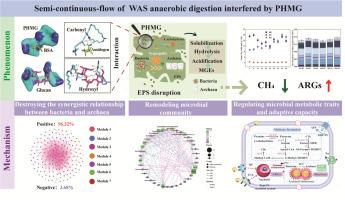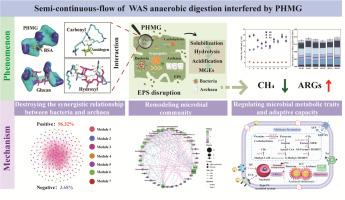非抗生素消毒剂在污泥厌氧消化过程中同步干扰甲烷的产生和抗生素耐药基因的繁殖:激活微生物的适应性并重新配置细菌与古细菌的协同作用
IF 11.4
1区 环境科学与生态学
Q1 ENGINEERING, ENVIRONMENTAL
引用次数: 0
摘要
废弃活性污泥(WAS)具有资源回收潜力和污染风险,因此对其进行高效处理具有挑战性。厌氧消化被广泛认为是一种绿色、可持续的废活性污泥处理方法,但其效率很容易受到废活性污泥中外在污染物的影响。然而,在半连续流条件下,聚六亚甲基胍(PHMG)作为一种广泛使用的非抗生素消毒剂,对废水消化的影响仍不清楚。在这项研究中,在低PHMG暴露和高PHMG暴露条件下,CH4产量分别从对照组的16.1 mL/g挥发性悬浮固体(VSS)降至13.2 mL/g VSS和0.3 mL/g VSS,而PHMG则使每个细菌的抗生素耐药基因(ARG)拷贝数增加了4.6-12.7%。分子对接分析表明,PHMG 可自发地与 WAS 结合并使其分解(结合能:2.35 和 -9.62 kcal/mol),从而增加了微生物接触 PHMG 的可能性。这导致细菌数量的增加和古细菌数量的减少,从而使细菌在生态位中占主导地位。经 PHMG 处理的反应器中的网络拓扑指数一直低于对照组,负相关链接的比例更高,这表明细菌和古细菌之间的关系更加对立。因此,PHMG 明显干扰了参与 CH4 生物合成的关键基因(如 mch 和 mtd)。有趣的是,在低 PHMG 暴露条件下,由于古细菌通过法定量感应和双组分系统进行适应,产甲烷活性和古细菌趋化性(如 rfk 和 cheA)得到了部分恢复。不过,这一适应过程也通过水平基因转移促进了 ARGs 的传播,而移动遗传因子和 ARGs 宿主的增强则为这一过程提供了便利。这些发现证实了 PHMG 的生态风险,并强调了有效 WAS 处置策略的必要性。本文章由计算机程序翻译,如有差异,请以英文原文为准。


Non-antibiotic disinfectant synchronously interferes methane production and antibiotic resistance genes propagation during sludge anaerobic digestion: Activation of microbial adaptation and reconfiguration of bacteria-archaea synergies
Waste activated sludge (WAS) presents both resource recovery potential and pollution risks, making its efficient treatment challenging. Anaerobic digestion is broadly recognized as a green and sustainable approach to WAS treatment, whose efficiency is easily impacted by the exogeneous pollutants in WAS. However, the impact of polyhexamethylene guanidine (PHMG), as a widely-used non-antibiotic disinfectant, on WAS digestion under semi-continuous flow conditions remains unclear. In this study, CH4 production decreased from 16.1 mL/g volatile suspended solids (VSS) in the control to 13.2 mL/g VSS and 0.3 mL/g VSS under low and high PHMG exposure, respectively, while PHMG increased the number of antibiotic resistance gene (ARG) copies per bacterium by 4.6–12.7 %. Molecular docking analysis revealed that PHMG could spontaneously bind to and disintegrate WAS (binding energy:2.35 and -9.62 kcal/mol), increasing the likelihood of microbial exposure to PHMG. This led to an increase in bacterial abundance and a reduction in archaeal populations, resulting in bacterial dominance in ecological niches. The network topology index in PHMG-treated reactors was consistently lower than in the control, with a higher proportion of negatively correlated links, indicating a more antagonistic relationship between bacteria and archaea. Consequently, PHMG significantly interfered with key genes involved in CH4 biosynthesis (e.g., mch and mtd). Interestingly, methanogenic activity and archaeal chemotaxis (e.g., rfk and cheA) partially recovered under low PHMG exposure due to archaeal adaptation through quorum sensing and two-component systems. However, this adaptation process also contributed to the propagation of ARGs through horizontal gene transfer, facilitated by the enhancement of mobile genetic elements and ARGs hosts. These findings confirm the ecological risks of PHMG and highlight the need for effective WAS disposal strategies.
求助全文
通过发布文献求助,成功后即可免费获取论文全文。
去求助
来源期刊

Water Research
环境科学-工程:环境
CiteScore
20.80
自引率
9.40%
发文量
1307
审稿时长
38 days
期刊介绍:
Water Research, along with its open access companion journal Water Research X, serves as a platform for publishing original research papers covering various aspects of the science and technology related to the anthropogenic water cycle, water quality, and its management worldwide. The audience targeted by the journal comprises biologists, chemical engineers, chemists, civil engineers, environmental engineers, limnologists, and microbiologists. The scope of the journal include:
•Treatment processes for water and wastewaters (municipal, agricultural, industrial, and on-site treatment), including resource recovery and residuals management;
•Urban hydrology including sewer systems, stormwater management, and green infrastructure;
•Drinking water treatment and distribution;
•Potable and non-potable water reuse;
•Sanitation, public health, and risk assessment;
•Anaerobic digestion, solid and hazardous waste management, including source characterization and the effects and control of leachates and gaseous emissions;
•Contaminants (chemical, microbial, anthropogenic particles such as nanoparticles or microplastics) and related water quality sensing, monitoring, fate, and assessment;
•Anthropogenic impacts on inland, tidal, coastal and urban waters, focusing on surface and ground waters, and point and non-point sources of pollution;
•Environmental restoration, linked to surface water, groundwater and groundwater remediation;
•Analysis of the interfaces between sediments and water, and between water and atmosphere, focusing specifically on anthropogenic impacts;
•Mathematical modelling, systems analysis, machine learning, and beneficial use of big data related to the anthropogenic water cycle;
•Socio-economic, policy, and regulations studies.
 求助内容:
求助内容: 应助结果提醒方式:
应助结果提醒方式:


